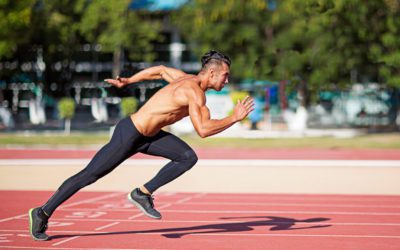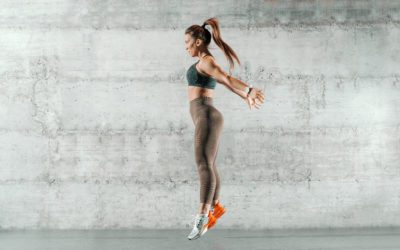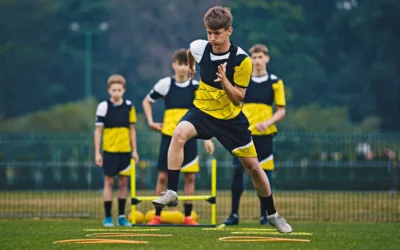Why Plyometrics Are Essential As You Age
TOPIC: Speed & Agility
As we age, our bodies slow and our power output trends downward. This affects a ton of fitness factors like your speed, balance, agility and the “pep in your step” later in life. Adding some simple plyos to your current training routine will give you an edge on your athletic power so you don’t miss a step.
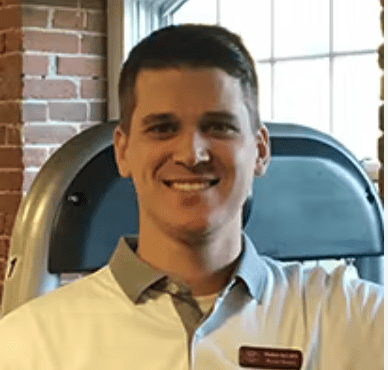
Written By
dr. matthew styf
Dr. Matthew Styf, PT, DPT is a Board Certified Orthopedic Clinical Specialist and Certified Strength & Conditioning Specialist at Blackstone Valley Physical Therapy. He works with athletes of all ages, with clinical interests in ACL rehab, golf performance, athletic development, and strength training.
Insta
Programs
Website
Putting the Pep Back in Your Step with Plyometrics
Even if you’re keeping up with your overall fitness as you age, you might be losing some of your “pep”.
So how do you prevent this? It boils down to having a consistent, well-rounded approach to your fitness. Even though you start to lose overall strength each decade past age 20, you can still gain muscle mass. But keeping muscle mass is only part of the equation for continued health as you age. You also need to work on your power.
Maintaining your current power output (or ever increasing it) as an adult is not necessarily done via what you see professional athletes doing. High-level, high-intensity power movements like cleans, snatches, and jerks are excellent strength and conditioning exercises. But there are other lower-impact, efficient movements to help you chip away at improving your athleticism.
Lower-level power or plyometric movements such as jumping rope, hopping, agility ladders, KB swings, and even sprinting can easily be added to a program to improve power as we age.
There are a lot of different schools of thought on what you should be doing and how you should go about it. But my advice is to find something that fits your goals and routine and go with it.
Adding plyometric or power work to your current workouts will help you feel more confident with dynamic athletic movements. Just make sure you add it to the beginning of your workout so you’re not doing it while fatigued.
Why Power Matters
So why power? Why does it matter? If you trip and catch yourself, it requires a sudden loading of the muscles and then a quick push back up to keep from falling over. If you don’t have enough power to do this, you’ll likely fall over, which can mean broken bones.
Power is moving weight fast and performing fast movements.
Many aging athletes don’t train as many fast-twitch muscle movements, which ultimately limits their overall power capabilities. Keeping tabs on your reaction time and motor control is also important for an aging brain. Training plyometrics helps with all of this.
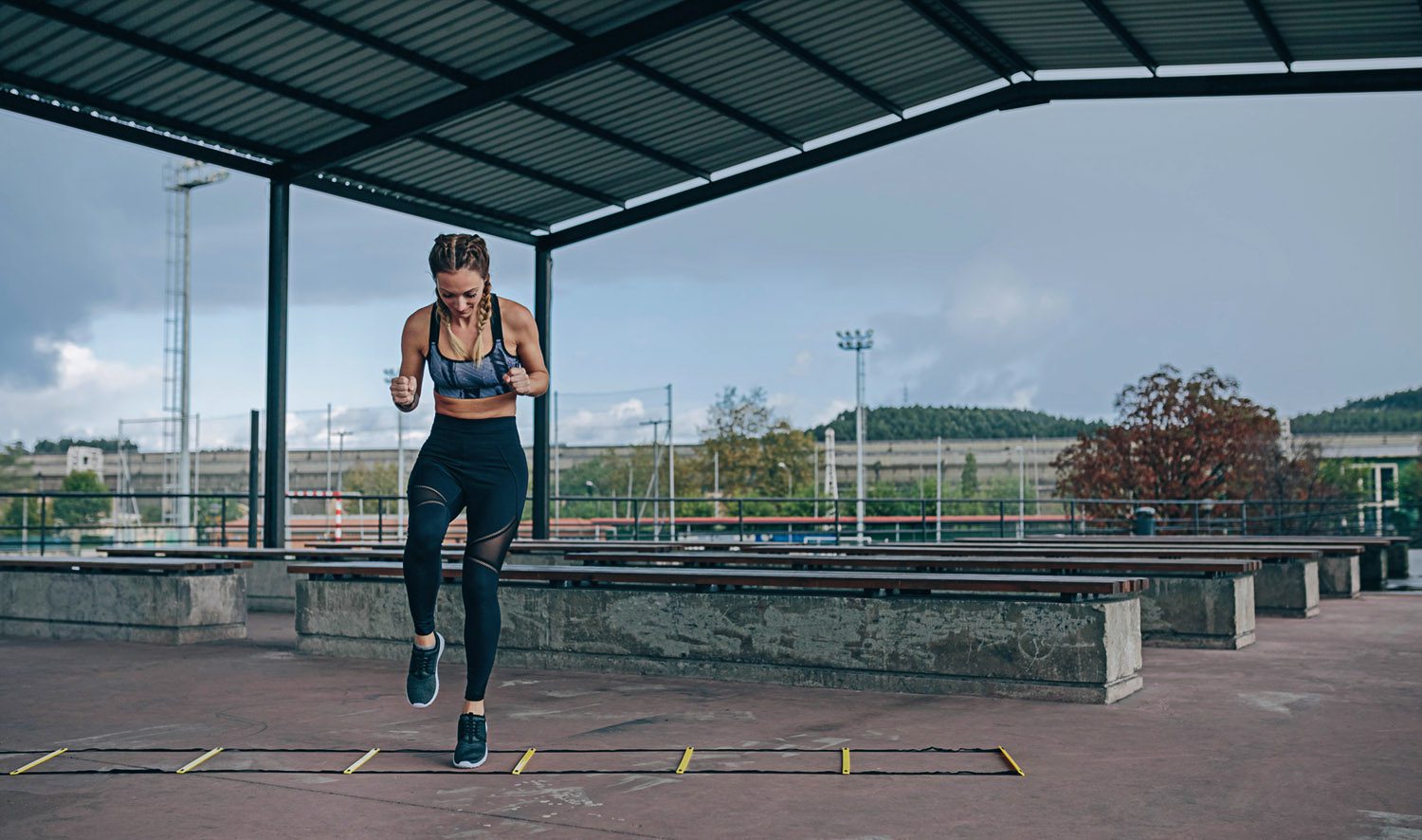
Plyometric & Power Progressions
I wouldn’t jump right into just any power variation that looks cool (because you may injure yourself). If you’re new to this type of training, start with something that has lower intensity, such as double-leg mini hops, agility ladders, or jumping rope.
This allows your bones, muscles, and tendons to adapt and build up the stiffness required to progress to more glamorous plyometrics. (Keep in mind that past injuries and other possible degenerative conditions may limit what you can perform.)
I recommend this progression to my athletes:
- Agility ladders
- Double-leg mini jumps
- Jump rope
- Single-leg mini jumps
- Band-assisted jumps
- Box jumps
- Broad jumps
- Sprints
- Weighted jumps
The starting point in the list above for each individual is different. A 30-year-old who has a history of athletics starts with higher level power development whereas a 50-year-old who is looking to improve fitness by starting a strength/power training regime needs to start with exercises that are less intense.
For example, the 30-year-old would plan for two total body workouts and alternate them in an ABA or BAB fashion using box jumps and sprints as the big two power movements.
The 50-year-old might start with the agility ladder and jump rope as their big 2 power movements. They can then advance through the progression fast (because they have a lower training age and are starting at a point that allows for more progression).
Does this mean the 50-year-old is making more gains in their power development compared to the 30-year-old? NO! It means the 30-year-old has fewer adaptations to make compared to an older person with a lower training age.
Be sure to check out this blog if you’re looking to land your first box jumps!
Box Jump Progression for Beginners
Ultimately, where you start compared to others doesn’t matter. What matters is that you start at a point that is appropriate for you and stay consistent with your approach. If you’re making gains each month or year, you’re doing it right.
Whether you’re programming for yourself or someone else is doing it for you, make sure you’re getting adequate power training in addition to strength and mobility. This will keep you ahead of your age and ensure you don’t lose that pep in your step.
Find Your Perfect Training Plan
Sometimes all you need to reach your destination on your fitness journey is an expert guide. Look no further, we've got you covered. Browse from thousands of programs for any goal and every type of athlete.
Try any programming subscription FREE for 7 days!
Related Articles
You May Also Like...
The Best Exercises to Improve Your Sprinting Speed
Looking to get a boost in your sprinting speed? Whether you’re striving for a personal best or just getting your legs and lungs back into the habit of running fast, these exercises will give you a more efficient, stronger and speedier stride.Written Bymorey croson...
5 Powerful Plyometric Exercises You Can Do Anywhere
Is your body aging, or are you aging your body? If you’re not training for power, chances are your bones are losing density. These five simple plyometrics exercises (that can be done almost anywhere!) maximize your power, reinforce your bones, and reduce your risk of...
System Based Agility Training
How do you approach training agility in a more holistic way? Agility is an important element of athletic success — being agile means more wins in your sport and fewer injuries on the field. Whether you're programming for yourself or your competitive athletes, take a...
The Best Exercises to Improve Your Sprinting Speed
Looking to get a boost in your sprinting speed? Whether you’re striving for a personal best or just getting your legs and lungs back into the habit of running fast, these exercises will give you a more efficient, stronger and speedier stride.Written Bymorey croson...
5 Powerful Plyometric Exercises You Can Do Anywhere
Is your body aging, or are you aging your body? If you’re not training for power, chances are your bones are losing density. These five simple plyometrics exercises (that can be done almost anywhere!) maximize your power, reinforce your bones, and reduce your risk of...

Want more training content?
Subscribe
For Coaches
For Athletes
About
Support
Training Lab
Access the latest articles, reviews, and case studies from the top strength and conditioning minds in the TH Training Lab!
Made with love, sweat, protein isolate and hard work in Denver, CO
© 2024 TrainHeroic, Inc. All rights reserved.
